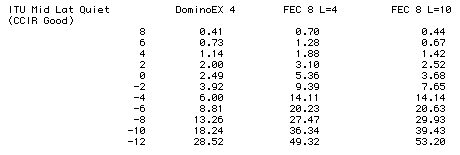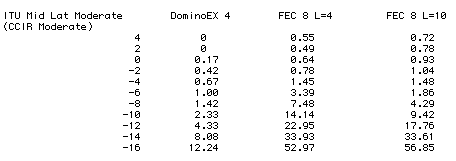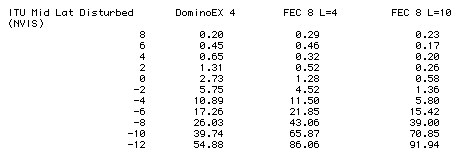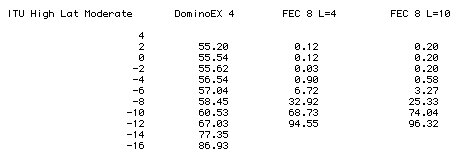DominoEX Performance
under ITU Propagation Profiles
Kok Chen, W7AY
[w7ay (at) arrl (dot) net]
Last updated: August 4, 2009
ITU Propagation Profiles
The smoothed Character Error Rates of DominoEX under some ITU Propagation profiles are charted. Please read the Measurements page to find the measurement methodology.
cocoaPath is used to generate the various HF propagation conditions. Character Error rate curves are charted for DominoEX 4, Domino EX 8 with FEC (using the default 4 stage interleaver) and DominoEX 8 with FEC (using a 10 stage interleaver).
Please note that the measurements here are recorded using cocoaModem's DominoEX demodulator; other software modems may give different results.
The FEC decoder in cocoaModem (also used for MFSK16) consists of a soft decision Viterbi Algorithm. The trellis depth for DominoEX is fixed at 21. The interleaver is implemented as a parametric one-pass algorithm that was earlier used in the cocoaModem MFSK16 decoder. As shown in the Raw Data tables here, the soft decoder in cocoaModem has about 0.25 dB advantage over the hard decoder.
The following is the list of propagation profiles that are charted. The profiles cover various Doppler spreading conditions; the narrowest spread is 0.1 Hz and the widest Doppler spread is 10 Hz. The 10 Hz spread represents what is commonly known as polar or trans-equatorial flutter.
Included in the list are multi-path profiles and one single-path profile. The multi-path profiles that have narrow Doppler spread often show up in in practice as selective fading, while the single path profile presents itself as a "flat" fading. Flat fading causes all DominoEX tones to fade by the same amount, while selective fading should benefit from an adaptive equalizer (not present in cocoaModem).
The ITU NVIS profile has the largest (7 ms) delay between the multiple paths.
Use the "chart" links below (or the tabs at the top of this page) to see the Character Error Rate charts for each of the profile.
- ITU Mid Latitude Quiet Conditions (CCIR Good
Condition) (Chart)
Two paths, both have 0.1 Hz frequency spread, with 0.5 ms delay between the paths.
- ITU Mid Latitude Moderate Conditions (CCIR
Moderate Condition) (Chart)
Two paths, both have 0.5 Hz frequency spread, with 1.0 ms delay between the two paths.
- ITU Mid Latitude Disturbed Conditions
(NVIS) (Chart)
Two paths, both have 1.0 Hz frequency spread, with 7.0 ms delay between the two paths.
- ITU High Latitude Moderate
Conditions (Chart)
Two paths, both have 0.5 Hz frequency spread, with 1.0 ms delay between the two paths.
- CCIR Flutter (Chart)
Two paths, both have 10.0 Hz frequency spread, with 0.5 ms delay between the two paths.
- CCIR Rayleigh Flat Fading (Medium)
(Chart)
A single path with 0.5 Hz frequency spread.
Observations
The reason we have chosen to compare the FEC version of DominoEX 8 with the reference non-FEC DominoEX 4 is because the character throughput (about 27 WPM) of these two modes are approximately equal. In spite of having similar character rates, the spectrum of a DominoEX 8 signal is about twice as wide as the spectrum of a DominoEX 4 signal, however.
Even with the use of FEC and using twice the bandwidth, DominoEX 8 is still not as sensitive as DominoEX 4 when conditions are good, such as represented by the ITU Mid Latitude Quiet (CCIR Good) and ITU Mid Latitude Moderate profiles. As seen here, DominoEX 4 is also more sensitive than the FEC version of DominoEX 8 when there is no Doppler scattering (i.e., when tested under AWGN conditions).
When conditions start to degrade, DominoEX 8 with FEC becomes increasingly better than DominoEX 4.
There is a slight sensitivity improvement of DominoEX 8 (FEC) over DominoEX 4 for the CCIR Flat Fading and ITU Mid Latitude NVIS Disturbed cases. For the flat fading case and about 1% character error rate, DominoEX 8 with a 10 stage FEC interleaver has about 5 dB of advantage over DominoEX 4. The advantage is a little smaller (about 4 dB) for the disturbed NVIS case.
DominoEX 8 with FEC finally proves very useful for poor high latitude and fluttered paths. For the CCIR Flutter and ITU High Latitude Moderate models, DominoEX 4 is not able to work no matter how much power is used, while DominoEX 8 with FEC gets through extremely efficiently.
Given enough power, RTTY can also work through these two propagation cases. However, DominoEX 8 with FEC appears to have about 12 dB to 16 dB of power advantage over RTTY under similarly poor conditions. For example, when there is sufficient flutter to require the use of a 1 kW RTTY transmitter to get a 1% character error rate, a 25 watt DominoEX 8 signal can perform just as well, as long as FEC is also turned on.
(For RTTY sensitivity, please refer to VE3NEA's measurements here.)
From the above observations, one possible conclusion is that unless one is working through high latitude disturbances or trans-equatorial flutter, it is better to use DominoEX 4. However, when there is flutter present, turning on FEC will permit communications when it is not possible at all with FEC turned off. The charts also show that there is a measurable advantage when a 10 stage interleaver is use in the place of the default 4 stage interleaver when conditions are poor. (Please note however that at least one existing software package does not have the option of switching to a 10 stage interleaver).
Raw Data
The following is a tabulation of the actual measured Beacon Channel error rate for DominoEX 4, and DominoEX 8 with FEC using 4 and 10 stage interleavers. The primary channel's error rates are derived from the beacon channel's error rates as described in the Measurements page.





